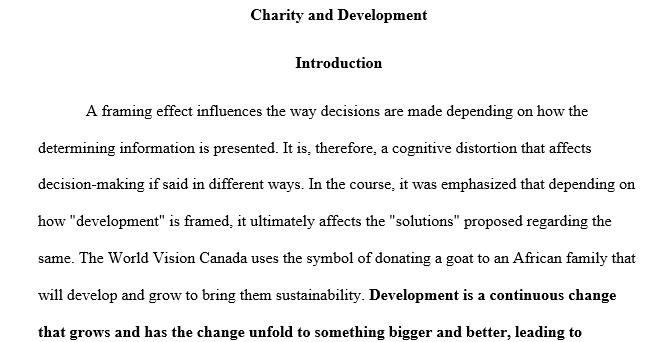In recent years, a highly popular appeal is to ask viewers to contribute towards the financing of a goat for an individual or a community
Instructions:
write an essay of no more than FIVE pages (double-spaced with 12 point fonts). The context and requirements of the essay are detailed below.
Context of the Question – Charity and Development
As we approach the holiday season, it is common to see advertising or campaigns by charities on television and on social media for donations to support their programs. Child sponsorship programmes such as those by Save the Children and women empowerment programs such as Because I am a Girl by Plan are well-known examples.
In recent years, a highly popular appeal is to ask viewers to contribute towards the financing of a goat for an individual or a community in a distant place in the “developing” world. The Canadian charity Feed the Children has a program on “Buy a Goat for a Family in Africa (Links to an external site.),” and Give a Goat for Christmas.
In this exam, we will focus on the “goat aid” program by World Vision.
This thirty-second video “It starts with your click” by World Vision Canada, suggests that “The simple act of choosing one small gift has the ability to set off a chain of events that can help transform the lives of children and the communities they live in.” Specifically, the narrative suggests that the goat will contribute to “sustainable income”, “education” and to a “lifetime of opportunity.”
While this video or the message paints an optimistic picture of the positive impact of charitable giving towards “development” outcomes, there are a number of assumptions that warrant close scrutiny. Many of these assumptions echo some of the “conventional wisdom” we examined in the course with regard to how to “fix poverty.”
In this essay, your task is to unpack the messages of the video carefully using the concepts and analytic lenses that you learned.
In this course we emphasized how “development” is framed affects the kind of “solutions” being proposed. How is “development” framed in the video? And how does the particular framing relate to the “solutions” being proposed?
We identified many “conventional wisdom” of development. What particular conventional wisdom have you identified in the video and why is this problematic?
Contexts, culture, places, history and politics matter when it comes to understanding the complexity of development. What is missing in the narrative of the video? What conceptual framework could you apply to better contextualize the issue(s) being addressed?
Despite the fundamentally different intentions and practices, charity or charitable giving is often seen as a form of development intervention. In what way has this video made visible the problem of equating development with charity?
How are you reading the message in the video differently after you are done with the previous steps? In other words, would you have questioned the assumptions of the “goat aid” or similar charitable giving schemes?
Expectations:
Your answers should be composed in the form of a critical reflective essay, but a thesis is a must. your answers and provide proper citations to sources using the APA style. A minimum of five sources, not including the lectures, should be cited. Feel free to draw on materials outside of assigned readings from the course as long as they are relevant.
You should compose your responses to the questions in a coherent narrative form, with a clear introduction, body text, and a conclusion. Essentially you can use question 1 for your introduction, questions 2 and 3 and 4 for the body of your paper, and question 5 for your conclusion. This is just a suggested format using the questions as a guide. You don’t have to follow them strictly.
Evaluation:
In our assessment of your response, we are looking for signs of critical engagement with the issues raised in the course. These include:
Critical engagement and application of appropriate course contents (theories, themes, concepts, structural analysis, readings, lectures, etc.)
Critical contextualization — identifying the broader social and political contexts and history of the issue rather than being purely descriptive
Evidence of reflexivity: Explaining and unpacking assumptions (e.g. consideration of positionality; consideration of ideological, epistemological and/or theoretical commitments etc.)
Praxis: How you plan to take up the insights/lessons learned
Compelling or persuasive use of appropriate example, evidence, illustrations
Appropriately research/sourcing/citation
Narrative flow: Conceptual coherence and/or consistency, initial framing is consistent with the conclusion
Readings and videos:
Arturo Escobar: a post-development thinker to be reckoned with | Global development | The Guardian
Niall Ferguson: The 6 killer apps of prosperity – YouTube
WE Charity’s international development efforts offered quick fixes, not real impact (theconversation.com)
Answer preview or In recent years, a highly popular appeal is to ask viewers to contribute towards the financing of a goat for an individual or a community

1350 Words